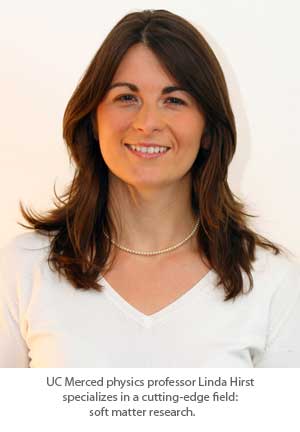

In between liquid and solid, there’s a kind of matter that we see much more than we realize. Soft matter includes everything from gels to rubber to most of the human body. That means understanding soft matter is important for human health as well as for technology applications like liquid crystal displays, or LCD monitors.
Professor Linda Hirstspecializes in soft matter physics as it’s applied in human health, materials science and technology. She studies how soft matter is assembled and how it changes under different conditions such as heating and cooling or electric fields.
For example, one current line of inquiry in Hirst’s lab examines how cholesterol and Omega-3s interact in cell membranes.
“Although our first response to those health buzzwords might be to label one bad and the other good, they both have important, everyday roles to play in our bodies,” Hirst said. “These functions require greater clarification on a basic science level so that researchers can eventually progress to medical breakthroughs.”
To that end, the National Science Foundation funded Hirst’s project on the topic with its prestigious CAREER Award last year, while she was on the faculty at Florida State University. She brought that research funding with her to UC Merced when she joined the faculty of the School of Natural Sciences in July 2008.
Another project addresses protein filament assembly - using the protein F-actin as inspiration for potential new gels based on similar semiflexible networks.
Like most areas in soft matter studies, semiflexible filament assembly is not yet well understood. Its potential for health or technology applications has yet to be discovered.
“It’s a new area of research,” Hirst explained.
That newness, along with the interdisciplinary reach of her research, creates a good fit for Hirst at UC Merced and in the Health Sciences Research Institute (formerly the Biomedical Sciences Research Institute).
Hirst also works on new materials for liquid crystal applications - the technology used for LCD televisions and computer monitors - testing new compounds developed by her colleagues from around the world.
For more information on soft matter, including a map of soft matter research groups worldwide, you can read up at Hirst’s
nonprofit Web site.






